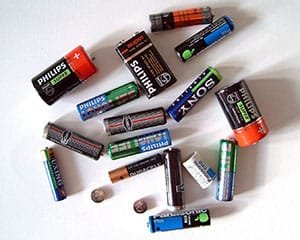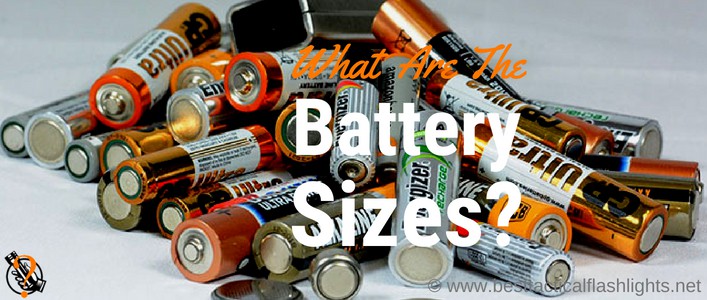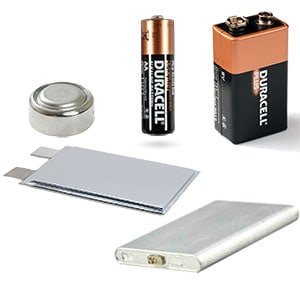How many times have you walked into a store and wondered about all the different battery sizes? Do you wonder why there are so many sizes? Ever wonder where they get their names from or what the difference is between them? If so you are not alone and we are here to help you answer some of these random questions. With how many battery sizes there are out there we simply can’t cover them all, but keep on reading to find out about the most common battery sizes for flashlights.
Why Are There so Many Different Battery Sizes?

As you have already learned from previous articles batteries are used to power a variety of devices. Batteries store chemical energy that is converted into electrical energy when the device is switched on. Knowing how batteries work is important to understanding why there are so many battery sizes.
Batteries are used to power a wide range of devices, including automobiles, lawnmowers, flashlights, watches, and much more. If you think about the different devices that use batteries for their power it is easy to see why there are so many different battery sizes. As we learned in our article ‘How Do Batteries Work’, the bigger the battery the more power it can store. Larger devices need more power so developers created the larger and more powerful batteries. As technology improved smaller versions of things were created. These smaller versions didn’t need the larger and more powerful batteries to operate so smaller batteries were developed.
Where do Battery Size Names Come From?
Battery size names were created by a group of manufacturers and government agencies working together. The battery manufacturers were the first ones to realize how important it was to put some common standards in place in regards to batteries. All of this was done to avoid having a new battery developed for every new device that came along.
International Electrotechnical Commission
In 1906 the International Electrotechnical Commission (IEC was formed in France to help develop standards for electrical products. Under the direction of the IEC are the TC21 and the TC35. The TC21 committee was founded in 1933 and is responsible for developing standards for rechargeable batteries. The TC35 committee was founded in 1948 and is responsible for the standards on primary batteries. The designation system that they currently use was established in 1992. The IEC committees use a letter/number sequence to identify the battery size. The sequence indicates the cell chemistry, cell shape, number of cells, dimensions, and any special characteristics the battery has.
American National Standards Institute
Battery standards came into play in the United States in 1919 when the National Bureau of Standards made their recommendations. In 1928 the American Standards Association, who was eventually replaced by the ANSI) released standard C18. This standard classified battery size using a letter code based on the size of the battery. “A” was the smallest and the sizes went up from there using the next letter of the alphabet. With these standards, the only battery size with a number code was a 6-inch tall battery labeled as a No. 6 cell. Every time new batteries were developed and added to the standard a new edition of C18 was released. American standards didn’t mesh with the IEC standard until the 12th Edition of C18 was released. In 1999, the ANSI standards were thoroughly revised to the edition used today. These standards use an arbitrary number to identify the size of the battery. A prefix letter identifies the shape, while suffix letters are used to describe terminals, chemistry, and other important battery features.
Understanding IEC Battery Standards
Battery standards are separated into three groups: primary, secondary, and lead-acid. We are going to discuss primary and secondary standards as these are the most common batteries used in flashlights.
Primary Battery Standards
All primary batteries using IEC standards use a series of letters and numbers to describe the features of the battery, including cell chemistry, shape, dimensions, number of cells, etc. With primary batteries in IEC standards, the first letter of the battery describes the chemical makeup of the battery.
 Shape Codes:
Shape Codes:
- R = Round –button, coin, or cylindrical
- P = Not Round
- F = Flat – no longer used to describe new definitions
- S = Square – no longer used to describe new definitions
Size Codes:
Size codes with the IEC standards are a bit more complicated than the shape codes. Batteries from previous editions of the IEC standards use one or two digit numbers to describe their size. Others use a four-digit number to describe the size; this number is the diameter and total height of the battery. These codes relate directly to the dimensions of the battery. Flat cells describe the diameter as the circle around the whole cell’s area. Round batteries use two-digit size codes, but not all round batteries use the current way of naming sizes these use standardized size codes that are listed in various charts. An example of this would be the R6 and R03, which the R6’s common name is AA and the R03’s common name is AAA.
Secondary Batteries
Secondary batteries include nickel-cadmium and nickel-metal hydride batteries along with lithium-ion batteries. Nickel-cadmium and nickel-metal hydride follow similar naming rules as the primary batteries. This is especially true for cylindrical cells that are designed to be interchangeable with their primary battery counterpart. Lithium-ion batteries, whether they are a multiple or single cell, follow an entirely different set of naming rules. These batteries use letters and numbers in a specific order to describe the battery. These are as follows:
- N(1) – number of connected cells
- A(1) – negative electrode phase
- A(2) – positive electrode phase
- A(3) – shape of the cell
- N(2) – maximum diameter
- N(3) – only for prismatic cells for maximum width
- N(4) – maximum total height
- N(5) – number of parallel connected cells
Understanding ANSI Battery Sizes
When ANSI standards were first released there were only carbon-zinc cells. With this being so simple a letter system was able to describe the dimensions of the battery. In 1924 the letters “A through J” were used to describe batteries from smallest to largest. The current edition used for batteries uses a numerical code to show the cell size. Flat cells use an F prefix and coin cells are given a size code in the 5000s. Secondary cells use different size codes, but they are interchangeable with specific primary cells. You just have to look at the specific dimensions to determine which secondary cell can be interchanged with which primary cell.
The good news is that now that the ANSI standards have meshed together with the IEC standards you can see what primary and secondary cells using IEC standards have the same dimensions as a primary or secondary cell following the ANSI standards. For example, an ANSI 13 Cell has the same dimensions as the IEC R20 cell, which it’s common or other name is a D cell.
What Are The Most Common Flashlight Battery Sizes?
If you do a Google Search on battery sizes, you will find charts listing all of the different battery sizes. These charts include every battery size and type available. These charts also include all of the important information used to describe each specific battery. With how many different sizes of batteries there are we simply cannot list them all. Instead, we will just provide you with a list of the most common battery sizes used in flashlights.
 10440
10440- 10180
- 14500
- 16340
- RCR123A
- 18350
- 18650
- 26650
- 32650
- AA
- AAA
- AAAA
- C
- D
- CR123A
- CR2
Batteries For Flashlights
Lets separate these into small and big batteries, we will set the AA battery as the biggest small battery.
Small Flashlight Batteries
AAAA Battery
The AAAA Battery is the smallest of the A standard lights. They are used in some really thin penlights with 2 stacked batteries. They are kinda hard to find and if you find them labeled as single AAAA they are pretty expensive. One hack to get cheaper AAAA batteries is that some 9V batteries are actually 6 AAAA wrapped up, you need to find the 9v with the code 6LR61 which stands for 6 LR61 batteries. LR61 batteries are not exactly the same as AAAA but they are very close and will work in most circumstances.
AAA Battery
A very popular battery that is found in most stores. AAA batteries can be primary or they can be rechargeable. They have an output range of 1.2-1.5 Volts.
AAA Batteries are very common in keychain lights since they are so small and easy to find.
AA Battery
The most popular and easiest to find batteries. They can be primary or rechargeable since AA is referencing a size and voltage range. They have an output range of 1.2-1.5 Volts.
In most high end flashlights this is where the standard size batteries stop. Rarely will you find a higher end flashlight with C or D size batteries.
CR2 Battery
The CR2 battery is popular in cameras and shows up frequently in really small lights. The C in CR2 means that it is a lithium battery (not li-ion). These are primary batteries which mean that they are not rechargeable. The CR2 battery is a 3 Volt battery.
The biggest advantage of these CR batteries including the CR123 is that they have a very low self discharge rate so they can last over 10 years without being used.
CR123 Battery
One of the most popular batteries for flashlights the CR123 is a lithium primary battery that can put out 3 Volts of power. Often the battery is favored over AA batteries because the 3 Volts that it can put out can create a brighter light.
10180 Battery
The 10180 battery is the first li-ion battery that we see on this list. Being a li-ion battery it has a voltage of 3.7 and is rechargeable. The issue with 10180 batteries is that they are so small that they have a small capacity, 70-100 mAh typically. The numbers designate the size 10mm diameter x 18mm length.
These batteries show up in super tiny keychain lights or lights that you can put on a necklace.
10440 Battery
This is often considered the AAA li-ion counterpart. There are lights that have electronics that can handle both Voltage levels. Being a li-ion battery this light has a voltage of 3.7 and is rechargeable. They typical capacity for 10440 batteries is 300-600mAh. The numbers in the name designate the size, 10mm diameter x 44mm length.
14500 Battery
The 14500 battery is the AA li-ion counterpart and many flashlight have electronics that can handle both. The numbers in the name designate the size of 14mm diameter x 50mm length. Being a li-ion battery it has a voltage of 3.7 and is rechargeable. The typical capacity for 14500 batteries is 650-900mAh.
16340/RCR123A Battery
The 16340 Battery and the RCR123A are pretty much used interchangeable they are one of the favored batteries aside from the 18650 battery for flashlights. Especially for EDC flashlights. The numbers in the name designate the size of 16mm diameter x 34mm length. Being li-ion batteries they have a voltage of 3.7 and they are rechargeable. The typical capacity for these are 550-900mAh
18350 Battery
The 18350 battery is a little newer on the flashlight scene but is becoming a favorite for high end custom flashlights. Like other li-ion batteries the numbers refer to 18mm diameter x 35mm length. They are 3.7 volts and rechargeable. The size of these is an almost unnoticeable amount bigger than 16340 but the typical capacity range is 750-1200mAh
Big Batteries For Flashlights
C Battery
C batteries can be primary or rechargeable but they are in the 1.2-1.5 Volt category, they are like AA batteries but with bigger capacity. These batteries are not usually used in higher end flashlights and you will find them mostly in big box store flashlights.
D Battery
D batteries are the same as C but just a bigger capacity.
18650 Battery
18650 batteries are probably the most used li-ion batteries. They are the batteries used in Teslas and lots of flashlights. These batteries were the main ones used in laptops for a long time. Being li-ion they are rechargeable and also the numbers represent the size, 18mm diameter x 65mm length. The capacity ranges from 2100-3600mAh.
21700 Battery
21700 batteries are kinda a new focus in the flashlight world since they are not much bigger than the 18650 batteries but they have lots more capacity. Again the numbers represent 21mm diameter x 70mm length but the capacities range from 3000-5100mAh. The most powerful light in the world is running off of 8 of these.
26650 Battery
26650 batteries are similar to the other li-ion batteries with 3.7 Volts. The size is 26mm diameter x 65mm length with capacities ranging from 4200-5200mAh.
32650 Battery
32650 batteries are similar to the other li-ion batteries with 3.7 Volts. The size is 32mm diameter x 65mm length with capacities around 6000mAh.
Flashlight Battery Sizes Final Thoughts
Thanks for visiting the site.
Understanding the different battery sizes can be a bit overwhelming. Battery sizes rely on a lot of technical jargon that most of us find it difficult and sometimes impossible to understand. Knowing the different battery sizes might not seem very important, but it does provide you with interesting knowledge. Knowing the different battery names and knowing the different sizes allows you to choose the right battery for your needs. No more guessing as to what the manufacturer recommends this size battery for this specific flashlight. Knowing the sizes and names allows you to understand what the letters and numbers actually mean. Please take a look at our flashlight reviews or our flashlight buyers guides for all your flashlight needs.
Footnotes:
- Wikipedia: List of battery sizes
- Power Stream: Standard Cylindrical Battery Sizes
- All Battery: Size Chart
- Wikipedia: Battery nomenclature

 Shape Codes:
Shape Codes: 10440
10440